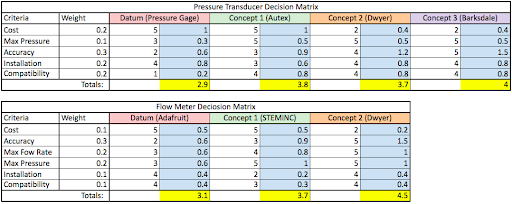Concept Generation for Sensors
Subsystem concepts were generated in accordance to research and benchmarking so once again each piece was taken on by the group members just as before; however, Seth also handled casting methods in this section on top of pumps.
Sensor Configuration
There are two main ways that the pressure sensors can be configured. Each method provides an adequate pressure reading, while not significantly interfering with the model. It is important to note that each configuration would only require one flow meter before the aneurysm, with no real significance in its placement, because flow rate can be assumed relatively constant throughout the modeled aorta. Both configurations are described below.
Two Pressure Transducers Surrounding Aneurysm
One configuration in which the pressure sensors can be set is right before and right after the aneurysm in the model. This way, a pressure difference can be measured which can determine an estimated pressure inside of the aneurysm. This method would be desirable because it would maintain the complete geometry of the aneurysm. However, this configuration would require two transducers to be purchased.
One Pressure Transducer at Aneurysm
Another configuration for the sensors is having only one transducer, located in the middle of the aneurysm. This setup will allow a pressure measurement to be made directly, rather than taking the difference between two points. This would create the need to create a tapping on the wall of the aneurysm, which could potentially alter the geometry and flow rate, which can skew the results. Nevertheless, this method would require only one transducer and, therefor, is more cost effective.
(This work along with the referances can be found in Reports under "Preliminary Reports")
Concept Selection for Sensors
The sensors that will be chosen must be able to handle the conditions that the model will be operating at. For example, the team has decided that the model will maintain a temperature of 37 °C, so the sensors must be able to withstand this temperature. Likewise, the sensors must be able to operate at a pressure between 68 and 141 mmHg, and a flow rate between 94 and 111 mL/s. Also, these sensors must be able to operate with water, or a similar fluid, as the working medium, otherwise the model will fail. Additionally, it is desired by the team that these sensors output an analog signal, and can be connected to any DAQ and GUI. Lastly, it is desired that the cost of these sensors not exceed five percent of the total budget per individual sensor. If sensor were to satisfy each of these criteria, it would likely be chosen.
"Pugh Matrix"
